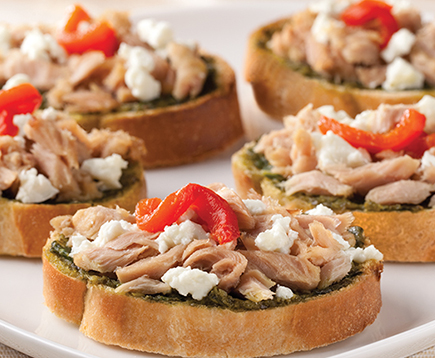Welcome to the StarKist Sustainability Knowledge Center. We’ve partnered with the International Seafood Sustainability Foundation (ISSF), a foundation charged with protecting the sustainability of seafood resources, to provide you with the latest news and resources to keep you informed about what’s being done to ensure the long-term health of tuna.
Below you will find:
Tuna Sustainability in the News
Latest headlines from ISSF:
Loading
Tuna 101 Fact Sheet
The following fact sheet provides some information to help you better understand tuna, as well as the sustainability efforts underway to monitor and protect our natural resources.
Healthy Stocks
- Tuna stocks of skipjack and light tuna, the most commonly eaten tuna in the U.S., are healthy and abundant. Also, skipjack accounts for the largest share of tuna caught and eaten by people around the world.
- U.S. tuna supplies are healthy and closely monitored. Light tuna, sourced primarily from skipjack tuna, is abundant and accounts for almost 70% of all the tuna eaten in the U.S. White tuna, also known as albacore, represents the remaining tuna.
- The International Seafood Sustainability Foundation (ISSF) has conservation measures in place to restore the vitality of others. The ISSF is a global partnership of marine scientists, the World Wildlife Fund and the largest global tuna brands. Together, they’re dedicated to managing today’s tuna supplies for future generations.
All About Albacore, Skipjack and Yellowfin
- The Albacore is the only kind of tuna that is classified as “white meat tuna" in the U.S. market. These fish typically weigh between 10 to 50 lbs. Albacore usually migrate across the Pacific Ocean from Japan and up the coast of North America.
- Skipjack is the smallest tuna and typically weights 6 to 12 pounds. Skipjack make up the largest share of tuna caught and eaten by people around the world. In fact, the majority of U.S. canned tuna is packed with skipjack. Skipjack live in warmer water temperatures and can be found in the central belt of water throughout the world.
- Yellowfin gets its name from the bright yellow color of its fins. This tuna can range in size from 30 to up to 400 pounds.
Tuna Trivia
- Tuna never stop moving, they are always in motion. That’s because of the tuna’s high demand for oxygen requires they move continuously — forcing water over their gills. Their minimum speed is approximately one body length per second.
- Tuna have been tracked crossing entire oceans. In fact, albacore tuna has been tracked 5,300 miles from California to Japan at the rate of 16 miles per day.
- Unlike most fish, which are cold-blooded, tuna are able to maintain their temperature several degrees warmer than the water in which they find themselves.
- A typical tuna may eat 5 percent of its own weight in food in one day. A tuna’s typical diet consistent of other fish, mollusks and crustaceans.
- Archaeological evidence shows that more than 6,000 years ago, tuna was harvested by early Europeans in the area around Sweden, by Native Americans near British Columbia and by the peoples of the Joman culture near Japan.
Making the Catch
- Purse Seining is a method to catch fish and it accounts for approximately 80 percent of the Light Meat tuna catch. A net is drawn out from the fishing boat and around the school of tuna. Weights carry one edge of the net deep into the water. When the fish are surrounded, the bottom of the net is drawn together so that the fish are trapped and hauled aboard the boat.
- Long-Lining is a method to catch Albacore tuna. A long line supported by floats and marked with flags is set out from a fishing boat. Branch lines attached to the long line are sunk with baited hooks to depths of 55 to 150 meters. It may take as many as 20 hours to set a line, and longer to retrieve it with its catch.
- Trolling or Pole and Line fishing is another way to catch tuna. Live bait is dumped from the fishing boat to bring tuna into a feeding frenzy. Fishermen drop lines with barbless hooks into the school of fish, and bring them aboard as they are hooked. (Source: International Seafood Sustainability Foundation)
Status of the Stocks
StarKist is actively working to ensure that plenty of tuna is around today…and for generations to come. Click on the link below to view a detailed map that reports on the most recent science available on stocks of tuna. This map provides insight on the impact of fishing and what’s being done to conserve these valuable resources.
Looking for more information? View the "Status of the World Fisheries for Tuna" report.
Additional Resources
Click the following links to view:
- About ISSF: The International Seafood Sustainability Foundation (ISSF) is a global partnership among leaders in science, the tuna industry and WWF, the global conservation organization. The organization’s mission is to undertake science-based initiatives for the long-term conservation and sustainable use of tuna stocks, reducing by-catch and promoting ecosystem health.
- About NFI: The National Fisheries Institute is a non-profit organization dedicated to education about seafood safety, sustainability, and nutrition. NFI promotes the US Dietary Guidelines that suggest Americans include fish and shellfish in their diets twice per week for longer, healthier lives.









